Analyzing Feminism Theory and Gender Inequality in Ancient History
VerifiedAdded on 2022/11/28
|9
|1628
|347
Essay
AI Summary
This essay delves into the application of feminism theory within the context of ancient history, exploring the pervasive nature of gender inequality from ancient times through the present. It examines various facets of this inequality, including discrimination, objectification, oppression, the influence of patriarchal societies, and the role of stereotyping. The essay analyzes how these themes manifest in different aspects of life, including art history and contemporary art, and discusses the implications for women's experiences and social roles. The analysis aims to understand the historical and societal factors that have shaped gender dynamics, offering insights into the evolution of these issues and their ongoing relevance. The essay utilizes various publications and sociological perspectives to provide a comprehensive understanding of the subject, concluding with an assessment of the progress made and the challenges that remain in achieving true gender equality.
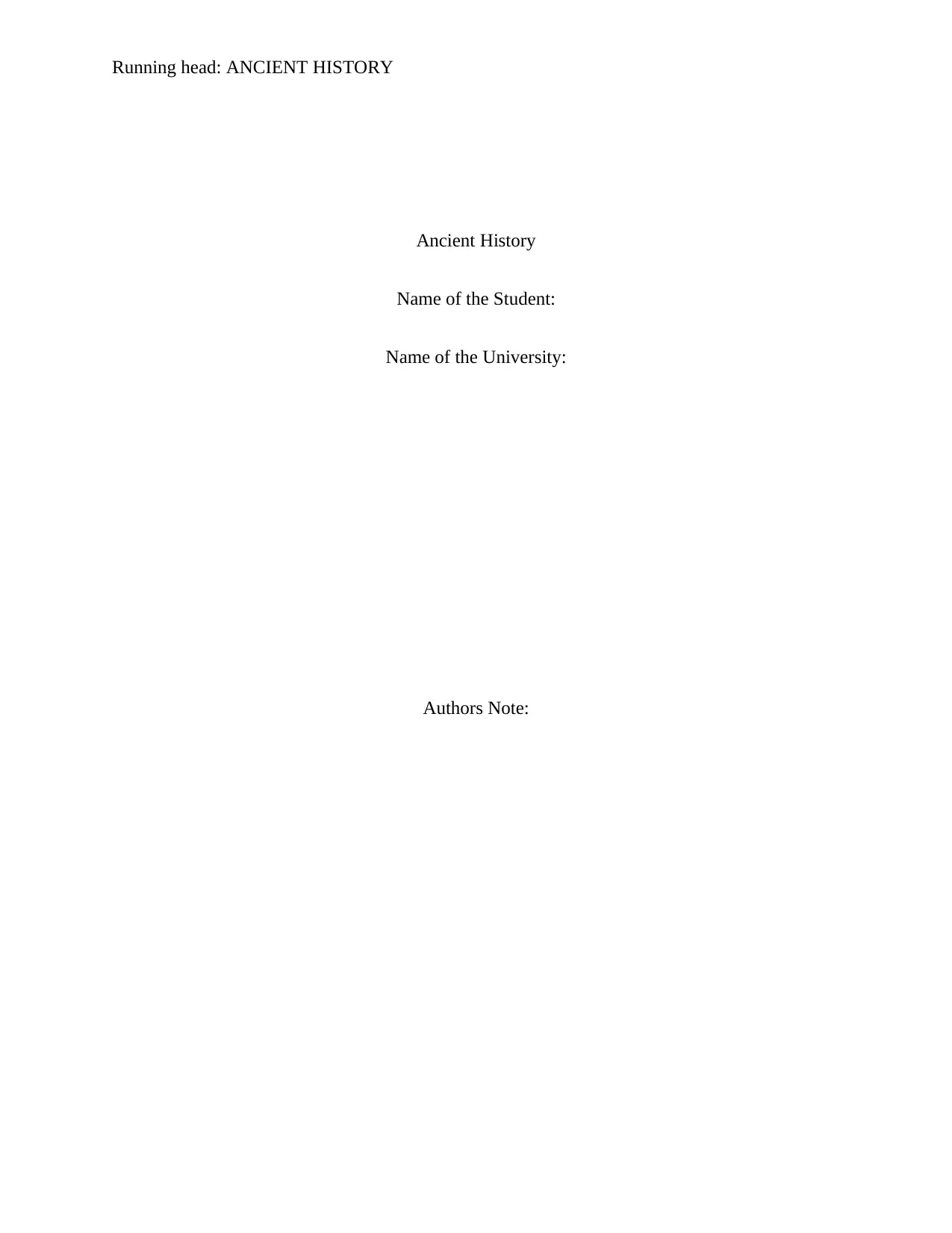
Running head: ANCIENT HISTORY
Ancient History
Name of the Student:
Name of the University:
Authors Note:
Ancient History
Name of the Student:
Name of the University:
Authors Note:
Paraphrase This Document
Need a fresh take? Get an instant paraphrase of this document with our AI Paraphraser
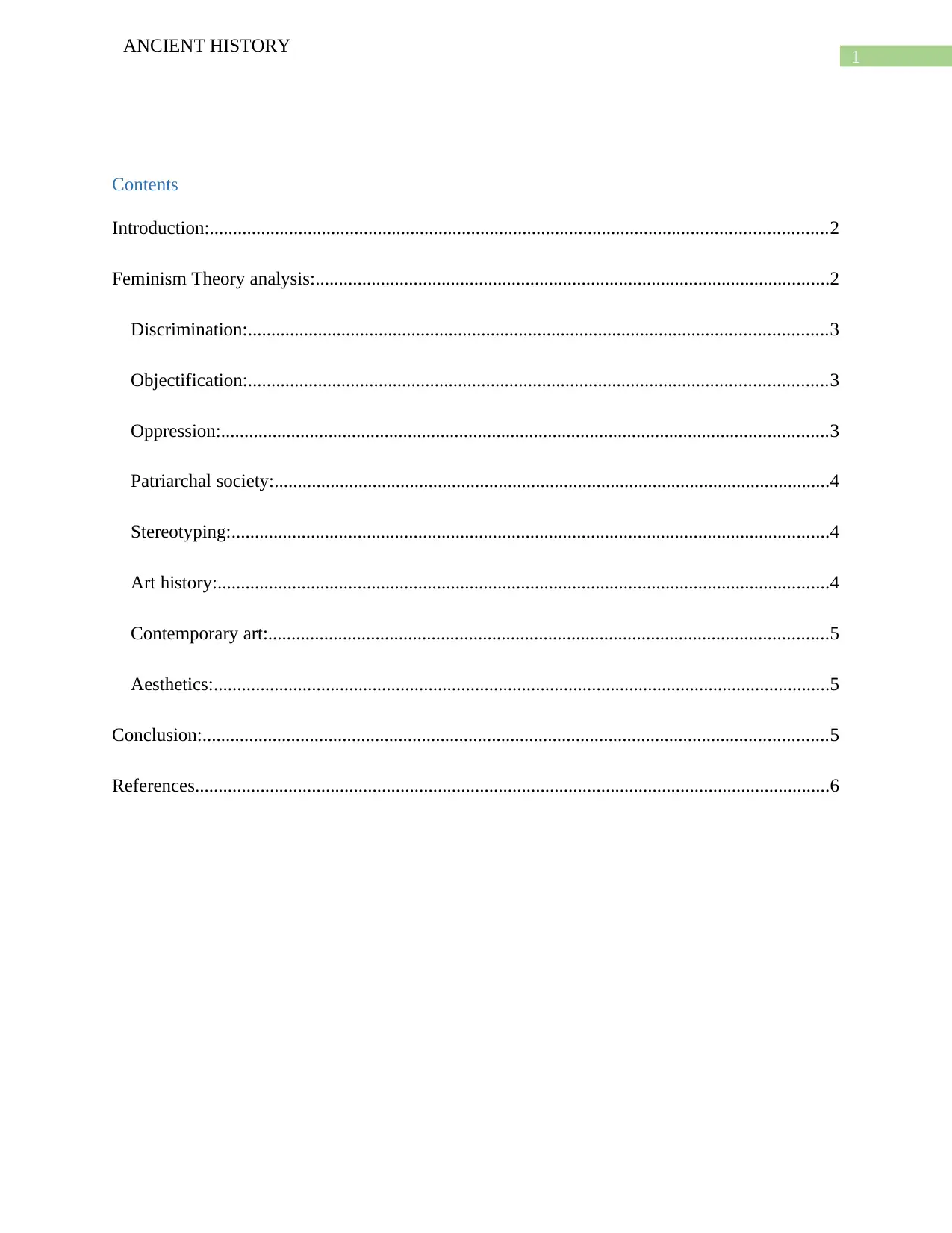
1
ANCIENT HISTORY
Contents
Introduction:....................................................................................................................................2
Feminism Theory analysis:..............................................................................................................2
Discrimination:............................................................................................................................3
Objectification:............................................................................................................................3
Oppression:..................................................................................................................................3
Patriarchal society:.......................................................................................................................4
Stereotyping:................................................................................................................................4
Art history:...................................................................................................................................4
Contemporary art:........................................................................................................................5
Aesthetics:....................................................................................................................................5
Conclusion:......................................................................................................................................5
References........................................................................................................................................6
ANCIENT HISTORY
Contents
Introduction:....................................................................................................................................2
Feminism Theory analysis:..............................................................................................................2
Discrimination:............................................................................................................................3
Objectification:............................................................................................................................3
Oppression:..................................................................................................................................3
Patriarchal society:.......................................................................................................................4
Stereotyping:................................................................................................................................4
Art history:...................................................................................................................................4
Contemporary art:........................................................................................................................5
Aesthetics:....................................................................................................................................5
Conclusion:......................................................................................................................................5
References........................................................................................................................................6
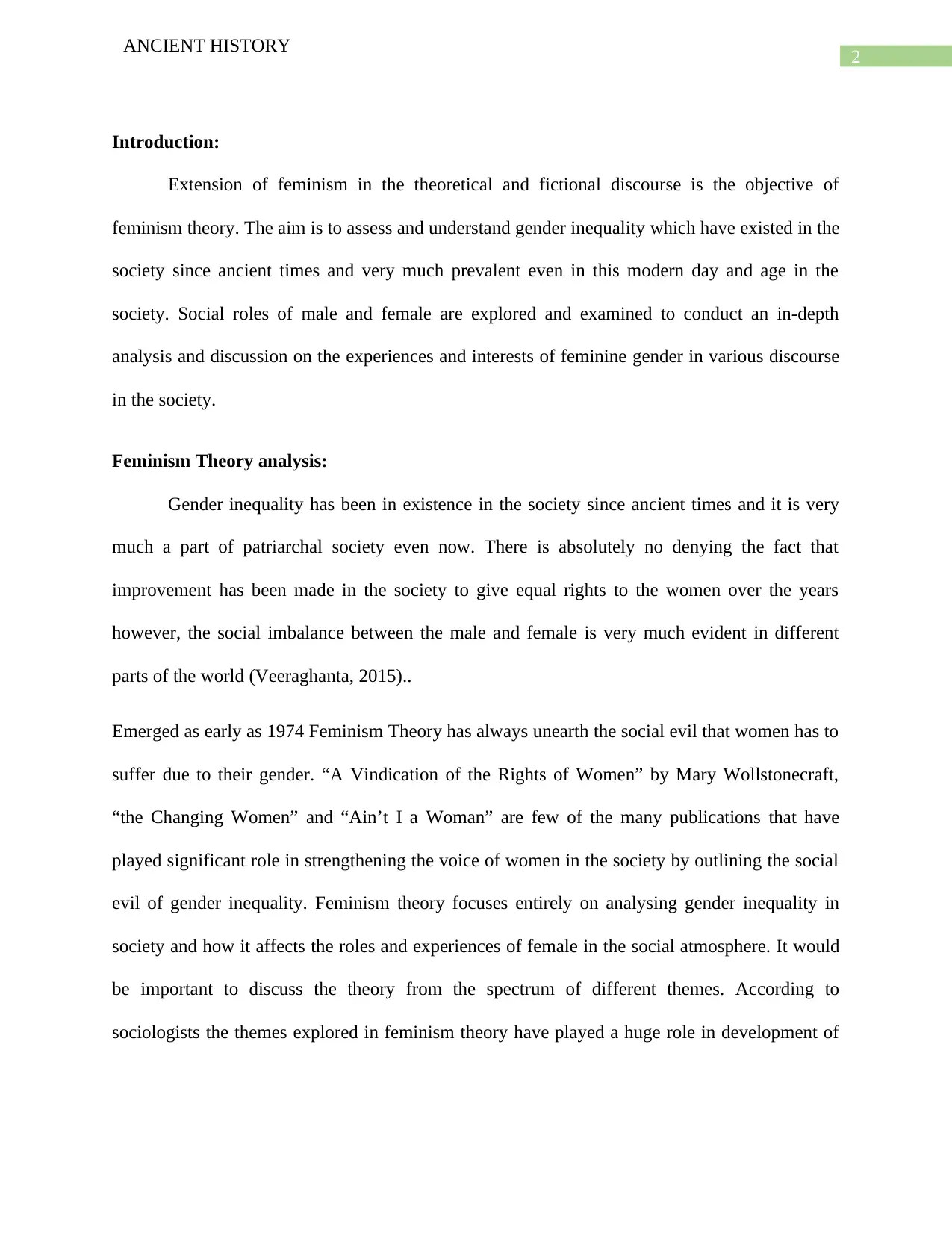
2
ANCIENT HISTORY
Introduction:
Extension of feminism in the theoretical and fictional discourse is the objective of
feminism theory. The aim is to assess and understand gender inequality which have existed in the
society since ancient times and very much prevalent even in this modern day and age in the
society. Social roles of male and female are explored and examined to conduct an in-depth
analysis and discussion on the experiences and interests of feminine gender in various discourse
in the society.
Feminism Theory analysis:
Gender inequality has been in existence in the society since ancient times and it is very
much a part of patriarchal society even now. There is absolutely no denying the fact that
improvement has been made in the society to give equal rights to the women over the years
however, the social imbalance between the male and female is very much evident in different
parts of the world (Veeraghanta, 2015)..
Emerged as early as 1974 Feminism Theory has always unearth the social evil that women has to
suffer due to their gender. “A Vindication of the Rights of Women” by Mary Wollstonecraft,
“the Changing Women” and “Ain’t I a Woman” are few of the many publications that have
played significant role in strengthening the voice of women in the society by outlining the social
evil of gender inequality. Feminism theory focuses entirely on analysing gender inequality in
society and how it affects the roles and experiences of female in the social atmosphere. It would
be important to discuss the theory from the spectrum of different themes. According to
sociologists the themes explored in feminism theory have played a huge role in development of
ANCIENT HISTORY
Introduction:
Extension of feminism in the theoretical and fictional discourse is the objective of
feminism theory. The aim is to assess and understand gender inequality which have existed in the
society since ancient times and very much prevalent even in this modern day and age in the
society. Social roles of male and female are explored and examined to conduct an in-depth
analysis and discussion on the experiences and interests of feminine gender in various discourse
in the society.
Feminism Theory analysis:
Gender inequality has been in existence in the society since ancient times and it is very
much a part of patriarchal society even now. There is absolutely no denying the fact that
improvement has been made in the society to give equal rights to the women over the years
however, the social imbalance between the male and female is very much evident in different
parts of the world (Veeraghanta, 2015)..
Emerged as early as 1974 Feminism Theory has always unearth the social evil that women has to
suffer due to their gender. “A Vindication of the Rights of Women” by Mary Wollstonecraft,
“the Changing Women” and “Ain’t I a Woman” are few of the many publications that have
played significant role in strengthening the voice of women in the society by outlining the social
evil of gender inequality. Feminism theory focuses entirely on analysing gender inequality in
society and how it affects the roles and experiences of female in the social atmosphere. It would
be important to discuss the theory from the spectrum of different themes. According to
sociologists the themes explored in feminism theory have played a huge role in development of
⊘ This is a preview!⊘
Do you want full access?
Subscribe today to unlock all pages.

Trusted by 1+ million students worldwide
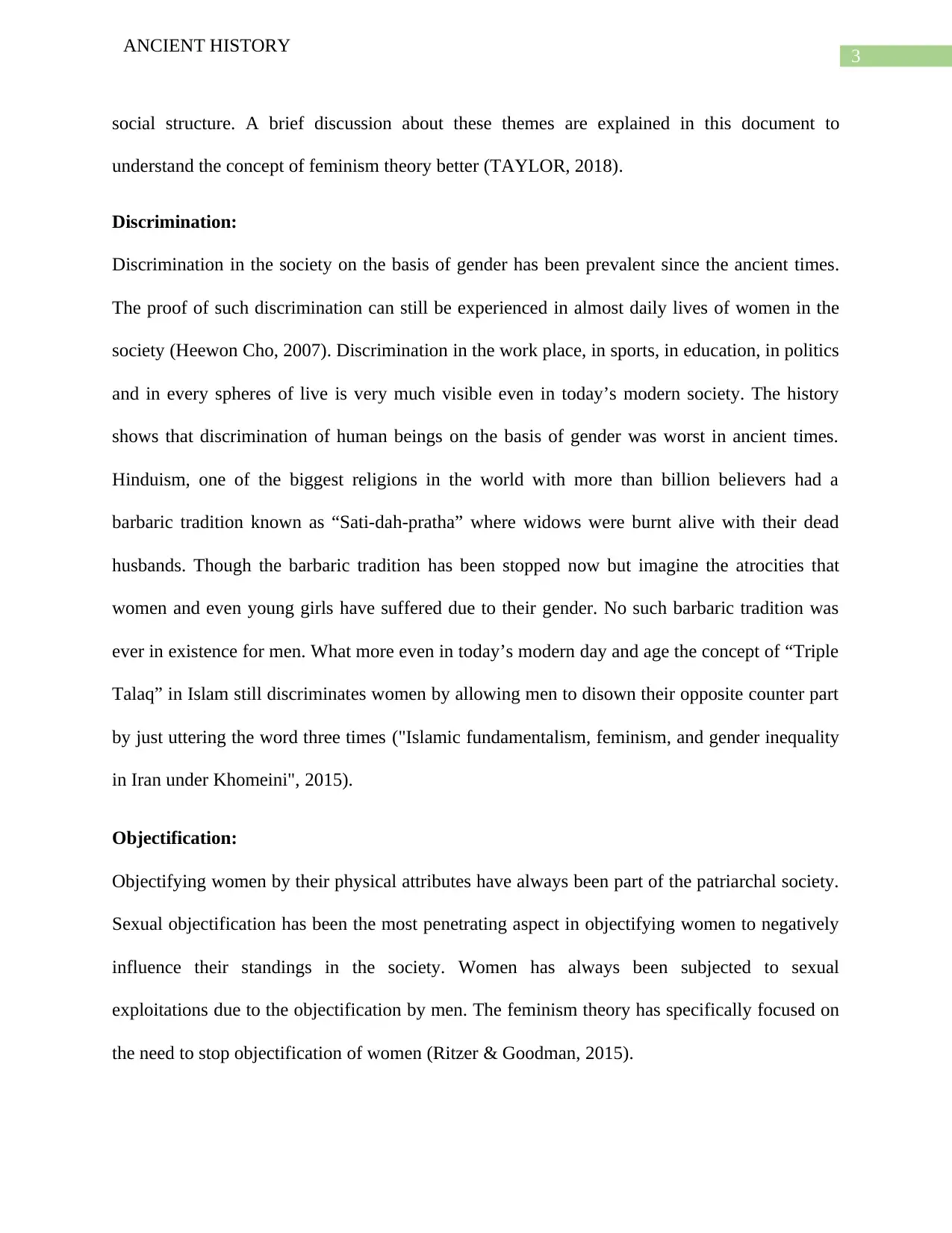
3
ANCIENT HISTORY
social structure. A brief discussion about these themes are explained in this document to
understand the concept of feminism theory better (TAYLOR, 2018).
Discrimination:
Discrimination in the society on the basis of gender has been prevalent since the ancient times.
The proof of such discrimination can still be experienced in almost daily lives of women in the
society (Heewon Cho, 2007). Discrimination in the work place, in sports, in education, in politics
and in every spheres of live is very much visible even in today’s modern society. The history
shows that discrimination of human beings on the basis of gender was worst in ancient times.
Hinduism, one of the biggest religions in the world with more than billion believers had a
barbaric tradition known as “Sati-dah-pratha” where widows were burnt alive with their dead
husbands. Though the barbaric tradition has been stopped now but imagine the atrocities that
women and even young girls have suffered due to their gender. No such barbaric tradition was
ever in existence for men. What more even in today’s modern day and age the concept of “Triple
Talaq” in Islam still discriminates women by allowing men to disown their opposite counter part
by just uttering the word three times ("Islamic fundamentalism, feminism, and gender inequality
in Iran under Khomeini", 2015).
Objectification:
Objectifying women by their physical attributes have always been part of the patriarchal society.
Sexual objectification has been the most penetrating aspect in objectifying women to negatively
influence their standings in the society. Women has always been subjected to sexual
exploitations due to the objectification by men. The feminism theory has specifically focused on
the need to stop objectification of women (Ritzer & Goodman, 2015).
ANCIENT HISTORY
social structure. A brief discussion about these themes are explained in this document to
understand the concept of feminism theory better (TAYLOR, 2018).
Discrimination:
Discrimination in the society on the basis of gender has been prevalent since the ancient times.
The proof of such discrimination can still be experienced in almost daily lives of women in the
society (Heewon Cho, 2007). Discrimination in the work place, in sports, in education, in politics
and in every spheres of live is very much visible even in today’s modern society. The history
shows that discrimination of human beings on the basis of gender was worst in ancient times.
Hinduism, one of the biggest religions in the world with more than billion believers had a
barbaric tradition known as “Sati-dah-pratha” where widows were burnt alive with their dead
husbands. Though the barbaric tradition has been stopped now but imagine the atrocities that
women and even young girls have suffered due to their gender. No such barbaric tradition was
ever in existence for men. What more even in today’s modern day and age the concept of “Triple
Talaq” in Islam still discriminates women by allowing men to disown their opposite counter part
by just uttering the word three times ("Islamic fundamentalism, feminism, and gender inequality
in Iran under Khomeini", 2015).
Objectification:
Objectifying women by their physical attributes have always been part of the patriarchal society.
Sexual objectification has been the most penetrating aspect in objectifying women to negatively
influence their standings in the society. Women has always been subjected to sexual
exploitations due to the objectification by men. The feminism theory has specifically focused on
the need to stop objectification of women (Ritzer & Goodman, 2015).
Paraphrase This Document
Need a fresh take? Get an instant paraphrase of this document with our AI Paraphraser
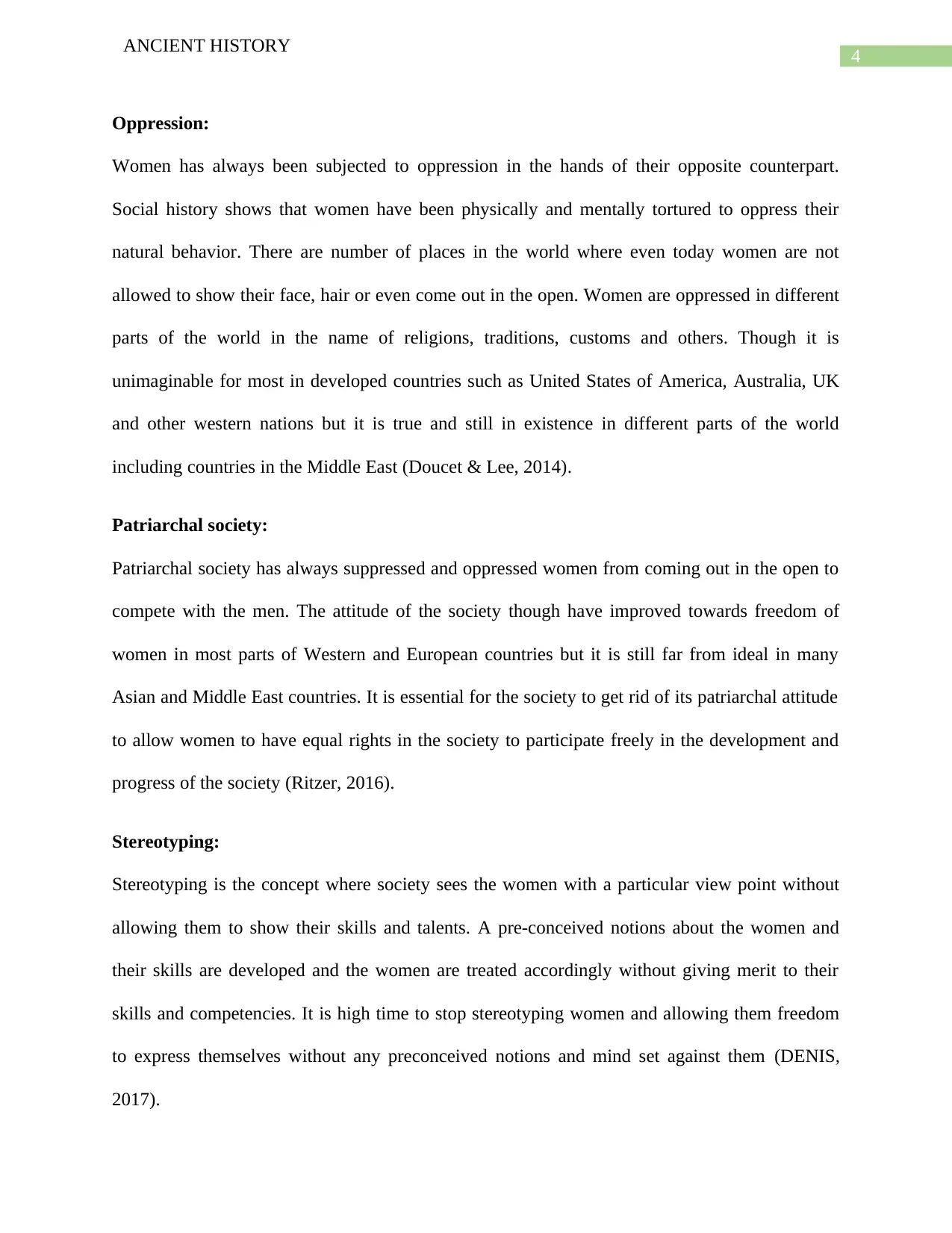
4
ANCIENT HISTORY
Oppression:
Women has always been subjected to oppression in the hands of their opposite counterpart.
Social history shows that women have been physically and mentally tortured to oppress their
natural behavior. There are number of places in the world where even today women are not
allowed to show their face, hair or even come out in the open. Women are oppressed in different
parts of the world in the name of religions, traditions, customs and others. Though it is
unimaginable for most in developed countries such as United States of America, Australia, UK
and other western nations but it is true and still in existence in different parts of the world
including countries in the Middle East (Doucet & Lee, 2014).
Patriarchal society:
Patriarchal society has always suppressed and oppressed women from coming out in the open to
compete with the men. The attitude of the society though have improved towards freedom of
women in most parts of Western and European countries but it is still far from ideal in many
Asian and Middle East countries. It is essential for the society to get rid of its patriarchal attitude
to allow women to have equal rights in the society to participate freely in the development and
progress of the society (Ritzer, 2016).
Stereotyping:
Stereotyping is the concept where society sees the women with a particular view point without
allowing them to show their skills and talents. A pre-conceived notions about the women and
their skills are developed and the women are treated accordingly without giving merit to their
skills and competencies. It is high time to stop stereotyping women and allowing them freedom
to express themselves without any preconceived notions and mind set against them (DENIS,
2017).
ANCIENT HISTORY
Oppression:
Women has always been subjected to oppression in the hands of their opposite counterpart.
Social history shows that women have been physically and mentally tortured to oppress their
natural behavior. There are number of places in the world where even today women are not
allowed to show their face, hair or even come out in the open. Women are oppressed in different
parts of the world in the name of religions, traditions, customs and others. Though it is
unimaginable for most in developed countries such as United States of America, Australia, UK
and other western nations but it is true and still in existence in different parts of the world
including countries in the Middle East (Doucet & Lee, 2014).
Patriarchal society:
Patriarchal society has always suppressed and oppressed women from coming out in the open to
compete with the men. The attitude of the society though have improved towards freedom of
women in most parts of Western and European countries but it is still far from ideal in many
Asian and Middle East countries. It is essential for the society to get rid of its patriarchal attitude
to allow women to have equal rights in the society to participate freely in the development and
progress of the society (Ritzer, 2016).
Stereotyping:
Stereotyping is the concept where society sees the women with a particular view point without
allowing them to show their skills and talents. A pre-conceived notions about the women and
their skills are developed and the women are treated accordingly without giving merit to their
skills and competencies. It is high time to stop stereotyping women and allowing them freedom
to express themselves without any preconceived notions and mind set against them (DENIS,
2017).
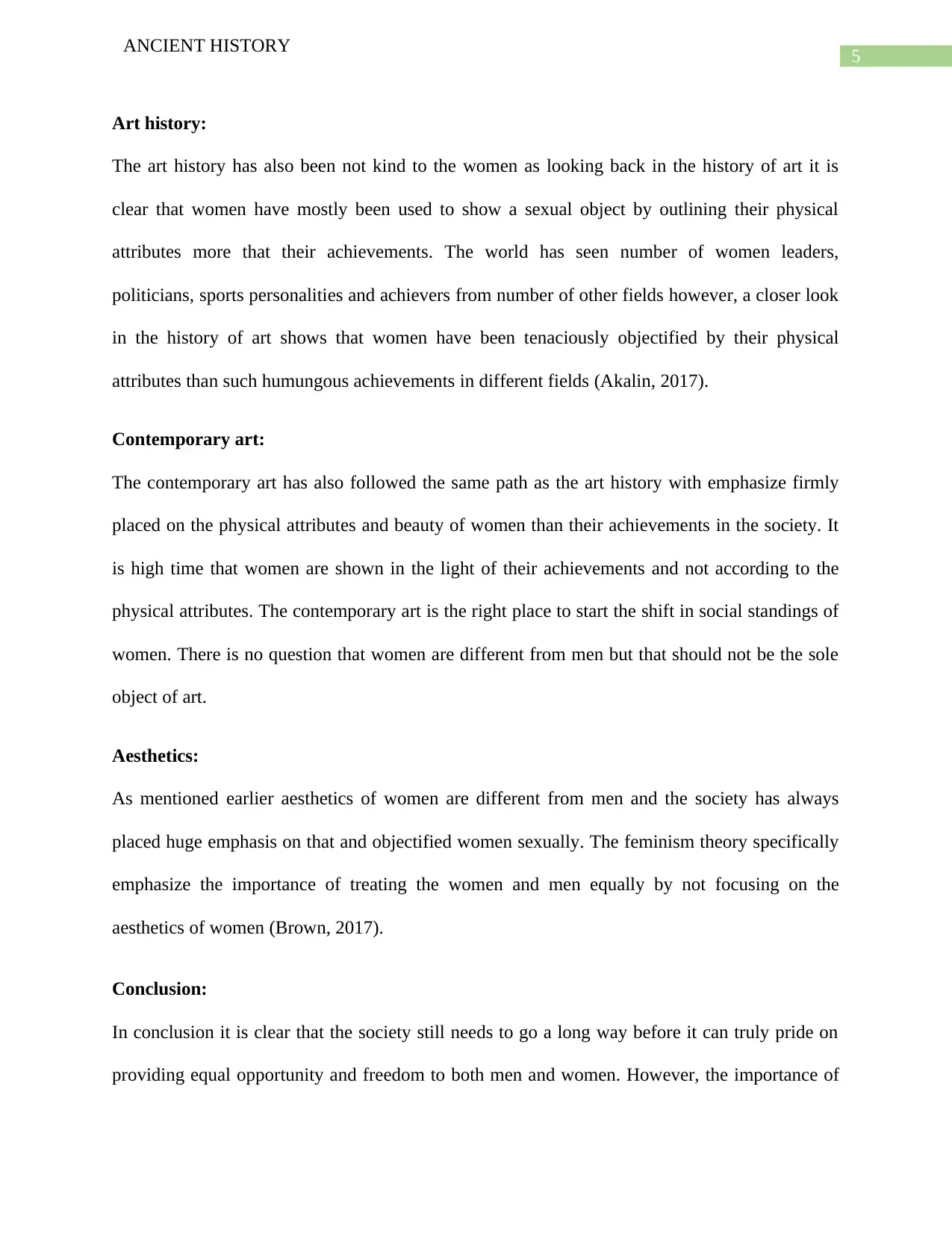
5
ANCIENT HISTORY
Art history:
The art history has also been not kind to the women as looking back in the history of art it is
clear that women have mostly been used to show a sexual object by outlining their physical
attributes more that their achievements. The world has seen number of women leaders,
politicians, sports personalities and achievers from number of other fields however, a closer look
in the history of art shows that women have been tenaciously objectified by their physical
attributes than such humungous achievements in different fields (Akalin, 2017).
Contemporary art:
The contemporary art has also followed the same path as the art history with emphasize firmly
placed on the physical attributes and beauty of women than their achievements in the society. It
is high time that women are shown in the light of their achievements and not according to the
physical attributes. The contemporary art is the right place to start the shift in social standings of
women. There is no question that women are different from men but that should not be the sole
object of art.
Aesthetics:
As mentioned earlier aesthetics of women are different from men and the society has always
placed huge emphasis on that and objectified women sexually. The feminism theory specifically
emphasize the importance of treating the women and men equally by not focusing on the
aesthetics of women (Brown, 2017).
Conclusion:
In conclusion it is clear that the society still needs to go a long way before it can truly pride on
providing equal opportunity and freedom to both men and women. However, the importance of
ANCIENT HISTORY
Art history:
The art history has also been not kind to the women as looking back in the history of art it is
clear that women have mostly been used to show a sexual object by outlining their physical
attributes more that their achievements. The world has seen number of women leaders,
politicians, sports personalities and achievers from number of other fields however, a closer look
in the history of art shows that women have been tenaciously objectified by their physical
attributes than such humungous achievements in different fields (Akalin, 2017).
Contemporary art:
The contemporary art has also followed the same path as the art history with emphasize firmly
placed on the physical attributes and beauty of women than their achievements in the society. It
is high time that women are shown in the light of their achievements and not according to the
physical attributes. The contemporary art is the right place to start the shift in social standings of
women. There is no question that women are different from men but that should not be the sole
object of art.
Aesthetics:
As mentioned earlier aesthetics of women are different from men and the society has always
placed huge emphasis on that and objectified women sexually. The feminism theory specifically
emphasize the importance of treating the women and men equally by not focusing on the
aesthetics of women (Brown, 2017).
Conclusion:
In conclusion it is clear that the society still needs to go a long way before it can truly pride on
providing equal opportunity and freedom to both men and women. However, the importance of
⊘ This is a preview!⊘
Do you want full access?
Subscribe today to unlock all pages.

Trusted by 1+ million students worldwide

6
ANCIENT HISTORY
feminism theory on improving the social balance between men and women cannot be explained
in such a small document.
ANCIENT HISTORY
feminism theory on improving the social balance between men and women cannot be explained
in such a small document.
Paraphrase This Document
Need a fresh take? Get an instant paraphrase of this document with our AI Paraphraser
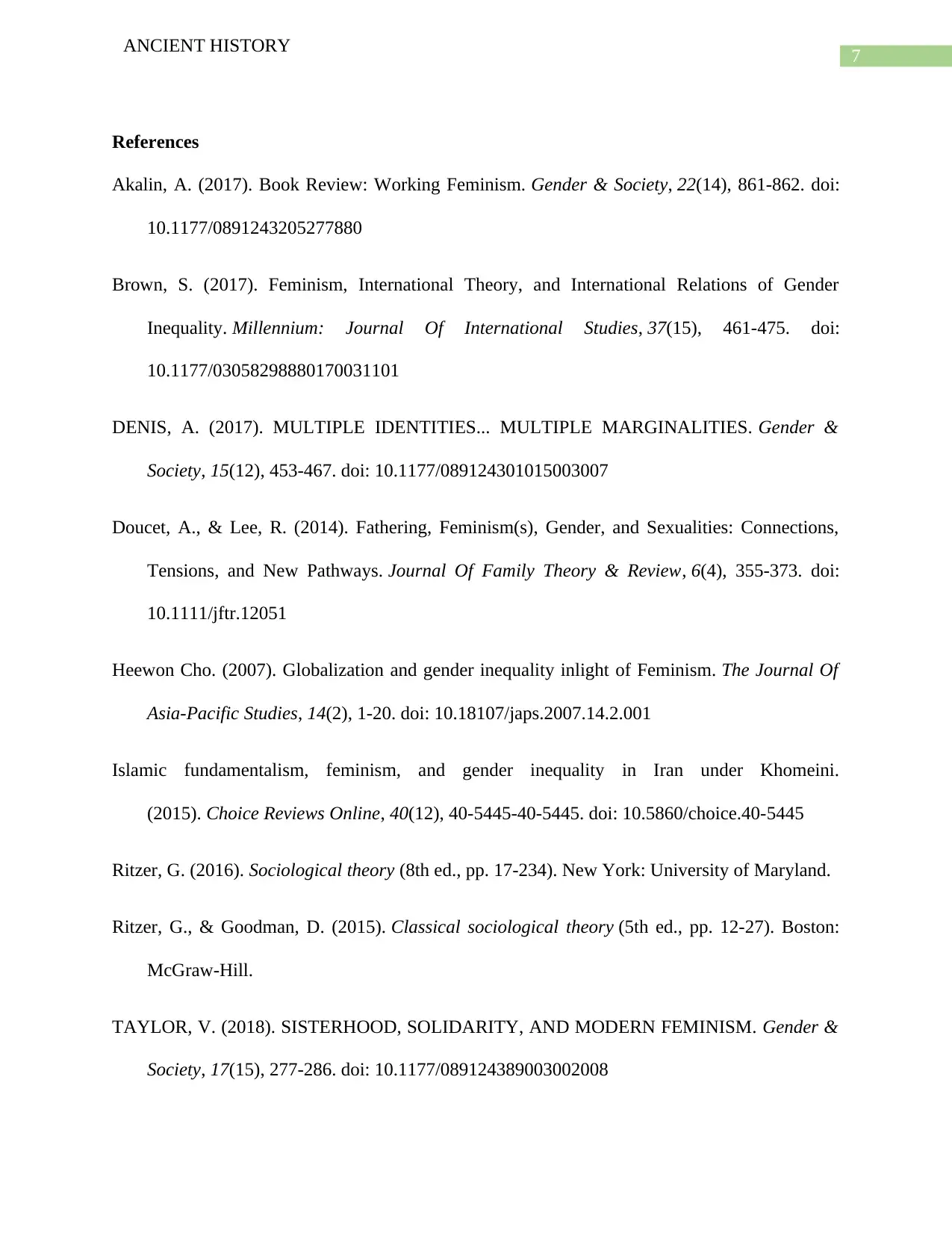
7
ANCIENT HISTORY
References
Akalin, A. (2017). Book Review: Working Feminism. Gender & Society, 22(14), 861-862. doi:
10.1177/0891243205277880
Brown, S. (2017). Feminism, International Theory, and International Relations of Gender
Inequality. Millennium: Journal Of International Studies, 37(15), 461-475. doi:
10.1177/03058298880170031101
DENIS, A. (2017). MULTIPLE IDENTITIES... MULTIPLE MARGINALITIES. Gender &
Society, 15(12), 453-467. doi: 10.1177/089124301015003007
Doucet, A., & Lee, R. (2014). Fathering, Feminism(s), Gender, and Sexualities: Connections,
Tensions, and New Pathways. Journal Of Family Theory & Review, 6(4), 355-373. doi:
10.1111/jftr.12051
Heewon Cho. (2007). Globalization and gender inequality inlight of Feminism. The Journal Of
Asia-Pacific Studies, 14(2), 1-20. doi: 10.18107/japs.2007.14.2.001
Islamic fundamentalism, feminism, and gender inequality in Iran under Khomeini.
(2015). Choice Reviews Online, 40(12), 40-5445-40-5445. doi: 10.5860/choice.40-5445
Ritzer, G. (2016). Sociological theory (8th ed., pp. 17-234). New York: University of Maryland.
Ritzer, G., & Goodman, D. (2015). Classical sociological theory (5th ed., pp. 12-27). Boston:
McGraw-Hill.
TAYLOR, V. (2018). SISTERHOOD, SOLIDARITY, AND MODERN FEMINISM. Gender &
Society, 17(15), 277-286. doi: 10.1177/089124389003002008
ANCIENT HISTORY
References
Akalin, A. (2017). Book Review: Working Feminism. Gender & Society, 22(14), 861-862. doi:
10.1177/0891243205277880
Brown, S. (2017). Feminism, International Theory, and International Relations of Gender
Inequality. Millennium: Journal Of International Studies, 37(15), 461-475. doi:
10.1177/03058298880170031101
DENIS, A. (2017). MULTIPLE IDENTITIES... MULTIPLE MARGINALITIES. Gender &
Society, 15(12), 453-467. doi: 10.1177/089124301015003007
Doucet, A., & Lee, R. (2014). Fathering, Feminism(s), Gender, and Sexualities: Connections,
Tensions, and New Pathways. Journal Of Family Theory & Review, 6(4), 355-373. doi:
10.1111/jftr.12051
Heewon Cho. (2007). Globalization and gender inequality inlight of Feminism. The Journal Of
Asia-Pacific Studies, 14(2), 1-20. doi: 10.18107/japs.2007.14.2.001
Islamic fundamentalism, feminism, and gender inequality in Iran under Khomeini.
(2015). Choice Reviews Online, 40(12), 40-5445-40-5445. doi: 10.5860/choice.40-5445
Ritzer, G. (2016). Sociological theory (8th ed., pp. 17-234). New York: University of Maryland.
Ritzer, G., & Goodman, D. (2015). Classical sociological theory (5th ed., pp. 12-27). Boston:
McGraw-Hill.
TAYLOR, V. (2018). SISTERHOOD, SOLIDARITY, AND MODERN FEMINISM. Gender &
Society, 17(15), 277-286. doi: 10.1177/089124389003002008

8
ANCIENT HISTORY
Veeraghanta, S. (2015). Book Review: Feminism without Borders: Decolonizing Theory,
Practicing Solidarity. Gender & Society, 27(7), 283-285. doi: 10.1177/0891243204264818
ANCIENT HISTORY
Veeraghanta, S. (2015). Book Review: Feminism without Borders: Decolonizing Theory,
Practicing Solidarity. Gender & Society, 27(7), 283-285. doi: 10.1177/0891243204264818
⊘ This is a preview!⊘
Do you want full access?
Subscribe today to unlock all pages.

Trusted by 1+ million students worldwide
1 out of 9
Related Documents
Your All-in-One AI-Powered Toolkit for Academic Success.
+13062052269
info@desklib.com
Available 24*7 on WhatsApp / Email
![[object Object]](/_next/static/media/star-bottom.7253800d.svg)
Unlock your academic potential
Copyright © 2020–2025 A2Z Services. All Rights Reserved. Developed and managed by ZUCOL.





